Internationalization Process of Tata Group: Case Study Analysis
VerifiedAdded on 2023/04/21
|14
|3493
|285
AI Summary
This case study analyzes the internationalization process of Tata Group, one of India's largest business houses. It explores the company's history, strategic intent, and major acquisitions, highlighting the challenges and successes of its global expansion.
Contribute Materials
Your contribution can guide someone’s learning journey. Share your
documents today.
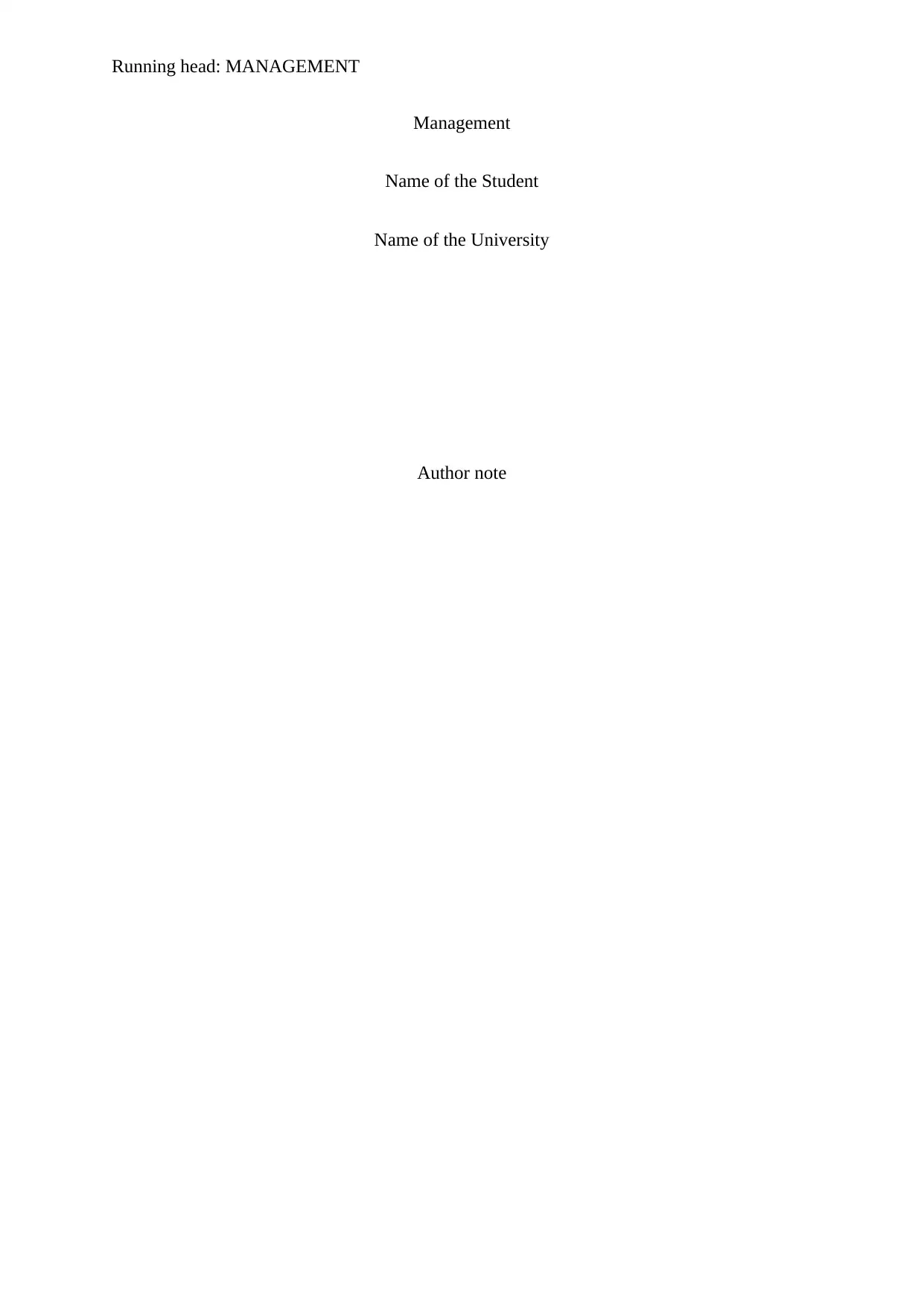
Running head: MANAGEMENT
Management
Name of the Student
Name of the University
Author note
Management
Name of the Student
Name of the University
Author note
Secure Best Marks with AI Grader
Need help grading? Try our AI Grader for instant feedback on your assignments.
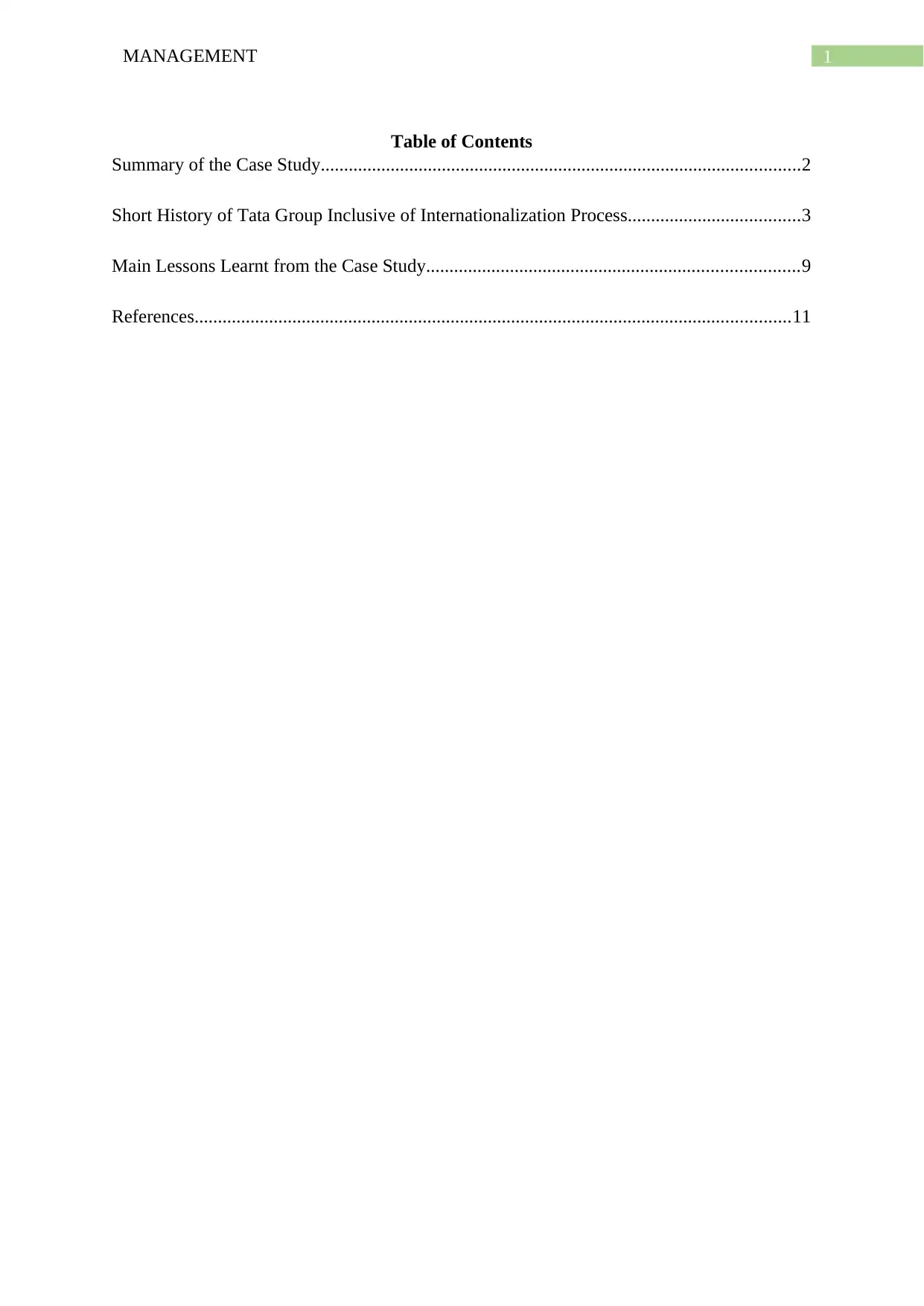
1MANAGEMENT
Table of Contents
Summary of the Case Study.......................................................................................................2
Short History of Tata Group Inclusive of Internationalization Process.....................................3
Main Lessons Learnt from the Case Study................................................................................9
References................................................................................................................................11
Table of Contents
Summary of the Case Study.......................................................................................................2
Short History of Tata Group Inclusive of Internationalization Process.....................................3
Main Lessons Learnt from the Case Study................................................................................9
References................................................................................................................................11
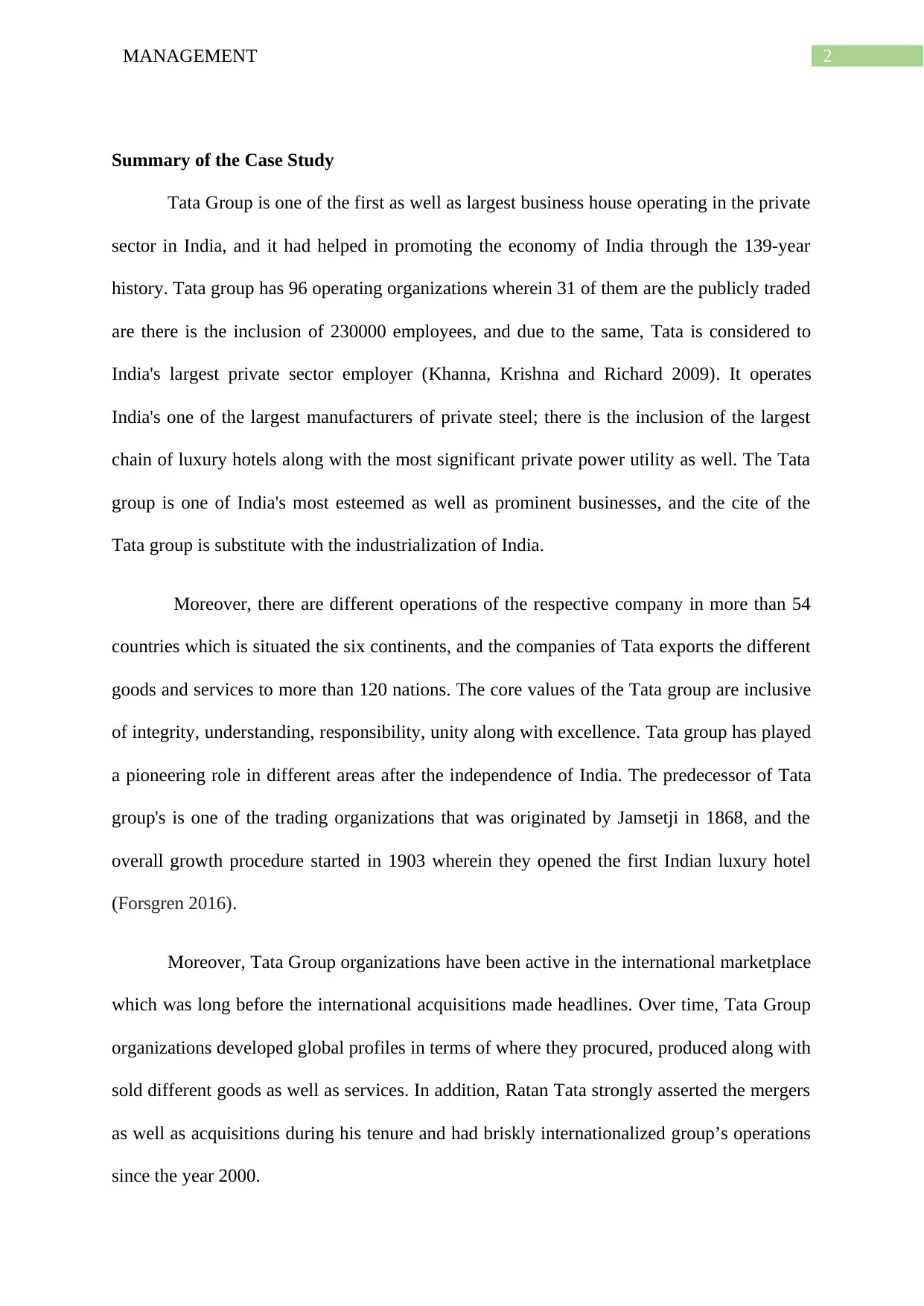
2MANAGEMENT
Summary of the Case Study
Tata Group is one of the first as well as largest business house operating in the private
sector in India, and it had helped in promoting the economy of India through the 139-year
history. Tata group has 96 operating organizations wherein 31 of them are the publicly traded
are there is the inclusion of 230000 employees, and due to the same, Tata is considered to
India's largest private sector employer (Khanna, Krishna and Richard 2009). It operates
India's one of the largest manufacturers of private steel; there is the inclusion of the largest
chain of luxury hotels along with the most significant private power utility as well. The Tata
group is one of India's most esteemed as well as prominent businesses, and the cite of the
Tata group is substitute with the industrialization of India.
Moreover, there are different operations of the respective company in more than 54
countries which is situated the six continents, and the companies of Tata exports the different
goods and services to more than 120 nations. The core values of the Tata group are inclusive
of integrity, understanding, responsibility, unity along with excellence. Tata group has played
a pioneering role in different areas after the independence of India. The predecessor of Tata
group's is one of the trading organizations that was originated by Jamsetji in 1868, and the
overall growth procedure started in 1903 wherein they opened the first Indian luxury hotel
(Forsgren 2016).
Moreover, Tata Group organizations have been active in the international marketplace
which was long before the international acquisitions made headlines. Over time, Tata Group
organizations developed global profiles in terms of where they procured, produced along with
sold different goods as well as services. In addition, Ratan Tata strongly asserted the mergers
as well as acquisitions during his tenure and had briskly internationalized group’s operations
since the year 2000.
Summary of the Case Study
Tata Group is one of the first as well as largest business house operating in the private
sector in India, and it had helped in promoting the economy of India through the 139-year
history. Tata group has 96 operating organizations wherein 31 of them are the publicly traded
are there is the inclusion of 230000 employees, and due to the same, Tata is considered to
India's largest private sector employer (Khanna, Krishna and Richard 2009). It operates
India's one of the largest manufacturers of private steel; there is the inclusion of the largest
chain of luxury hotels along with the most significant private power utility as well. The Tata
group is one of India's most esteemed as well as prominent businesses, and the cite of the
Tata group is substitute with the industrialization of India.
Moreover, there are different operations of the respective company in more than 54
countries which is situated the six continents, and the companies of Tata exports the different
goods and services to more than 120 nations. The core values of the Tata group are inclusive
of integrity, understanding, responsibility, unity along with excellence. Tata group has played
a pioneering role in different areas after the independence of India. The predecessor of Tata
group's is one of the trading organizations that was originated by Jamsetji in 1868, and the
overall growth procedure started in 1903 wherein they opened the first Indian luxury hotel
(Forsgren 2016).
Moreover, Tata Group organizations have been active in the international marketplace
which was long before the international acquisitions made headlines. Over time, Tata Group
organizations developed global profiles in terms of where they procured, produced along with
sold different goods as well as services. In addition, Ratan Tata strongly asserted the mergers
as well as acquisitions during his tenure and had briskly internationalized group’s operations
since the year 2000.
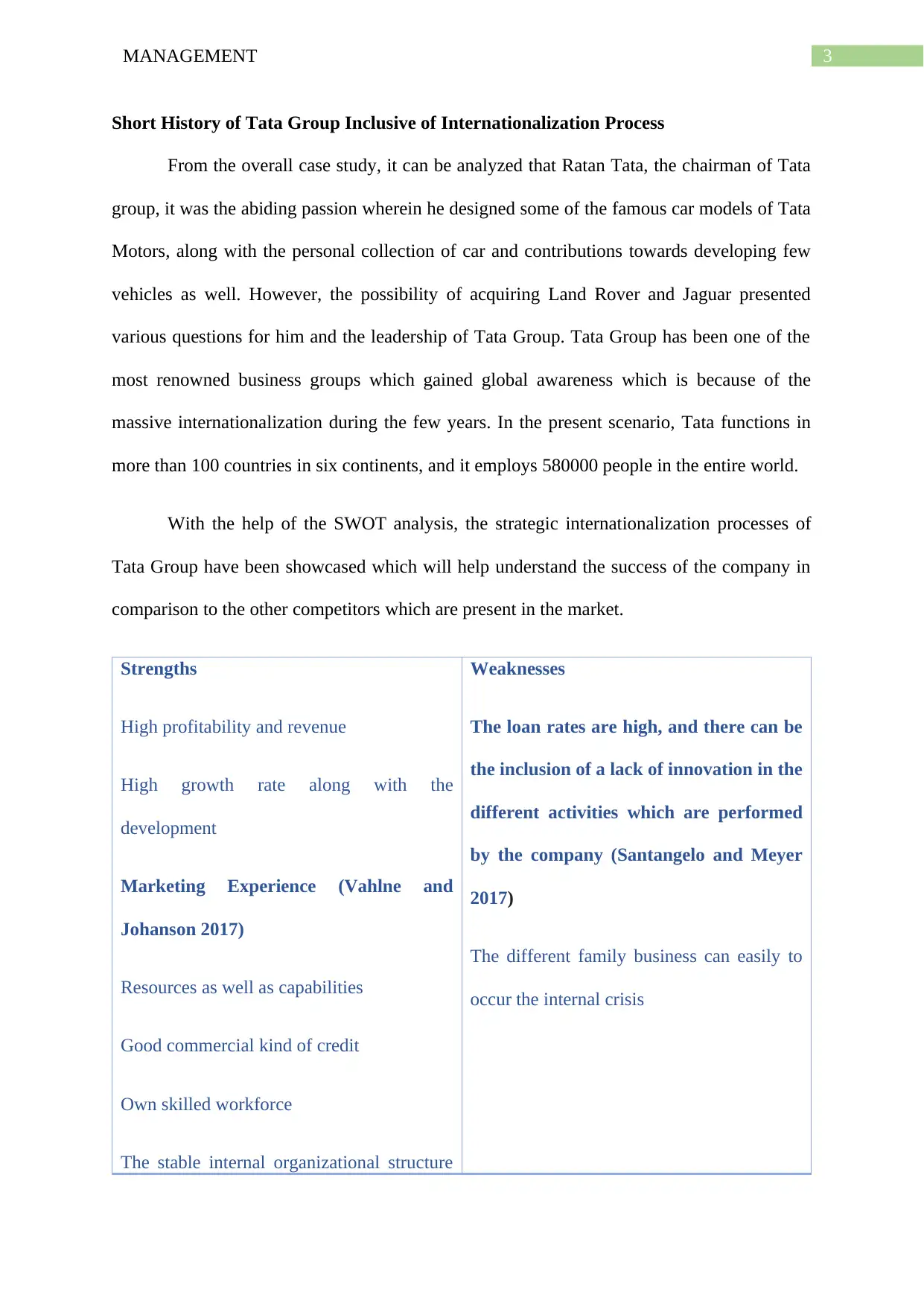
3MANAGEMENT
Short History of Tata Group Inclusive of Internationalization Process
From the overall case study, it can be analyzed that Ratan Tata, the chairman of Tata
group, it was the abiding passion wherein he designed some of the famous car models of Tata
Motors, along with the personal collection of car and contributions towards developing few
vehicles as well. However, the possibility of acquiring Land Rover and Jaguar presented
various questions for him and the leadership of Tata Group. Tata Group has been one of the
most renowned business groups which gained global awareness which is because of the
massive internationalization during the few years. In the present scenario, Tata functions in
more than 100 countries in six continents, and it employs 580000 people in the entire world.
With the help of the SWOT analysis, the strategic internationalization processes of
Tata Group have been showcased which will help understand the success of the company in
comparison to the other competitors which are present in the market.
Strengths
High profitability and revenue
High growth rate along with the
development
Marketing Experience (Vahlne and
Johanson 2017)
Resources as well as capabilities
Good commercial kind of credit
Own skilled workforce
The stable internal organizational structure
Weaknesses
The loan rates are high, and there can be
the inclusion of a lack of innovation in the
different activities which are performed
by the company (Santangelo and Meyer
2017)
The different family business can easily to
occur the internal crisis
Short History of Tata Group Inclusive of Internationalization Process
From the overall case study, it can be analyzed that Ratan Tata, the chairman of Tata
group, it was the abiding passion wherein he designed some of the famous car models of Tata
Motors, along with the personal collection of car and contributions towards developing few
vehicles as well. However, the possibility of acquiring Land Rover and Jaguar presented
various questions for him and the leadership of Tata Group. Tata Group has been one of the
most renowned business groups which gained global awareness which is because of the
massive internationalization during the few years. In the present scenario, Tata functions in
more than 100 countries in six continents, and it employs 580000 people in the entire world.
With the help of the SWOT analysis, the strategic internationalization processes of
Tata Group have been showcased which will help understand the success of the company in
comparison to the other competitors which are present in the market.
Strengths
High profitability and revenue
High growth rate along with the
development
Marketing Experience (Vahlne and
Johanson 2017)
Resources as well as capabilities
Good commercial kind of credit
Own skilled workforce
The stable internal organizational structure
Weaknesses
The loan rates are high, and there can be
the inclusion of a lack of innovation in the
different activities which are performed
by the company (Santangelo and Meyer
2017)
The different family business can easily to
occur the internal crisis
Secure Best Marks with AI Grader
Need help grading? Try our AI Grader for instant feedback on your assignments.
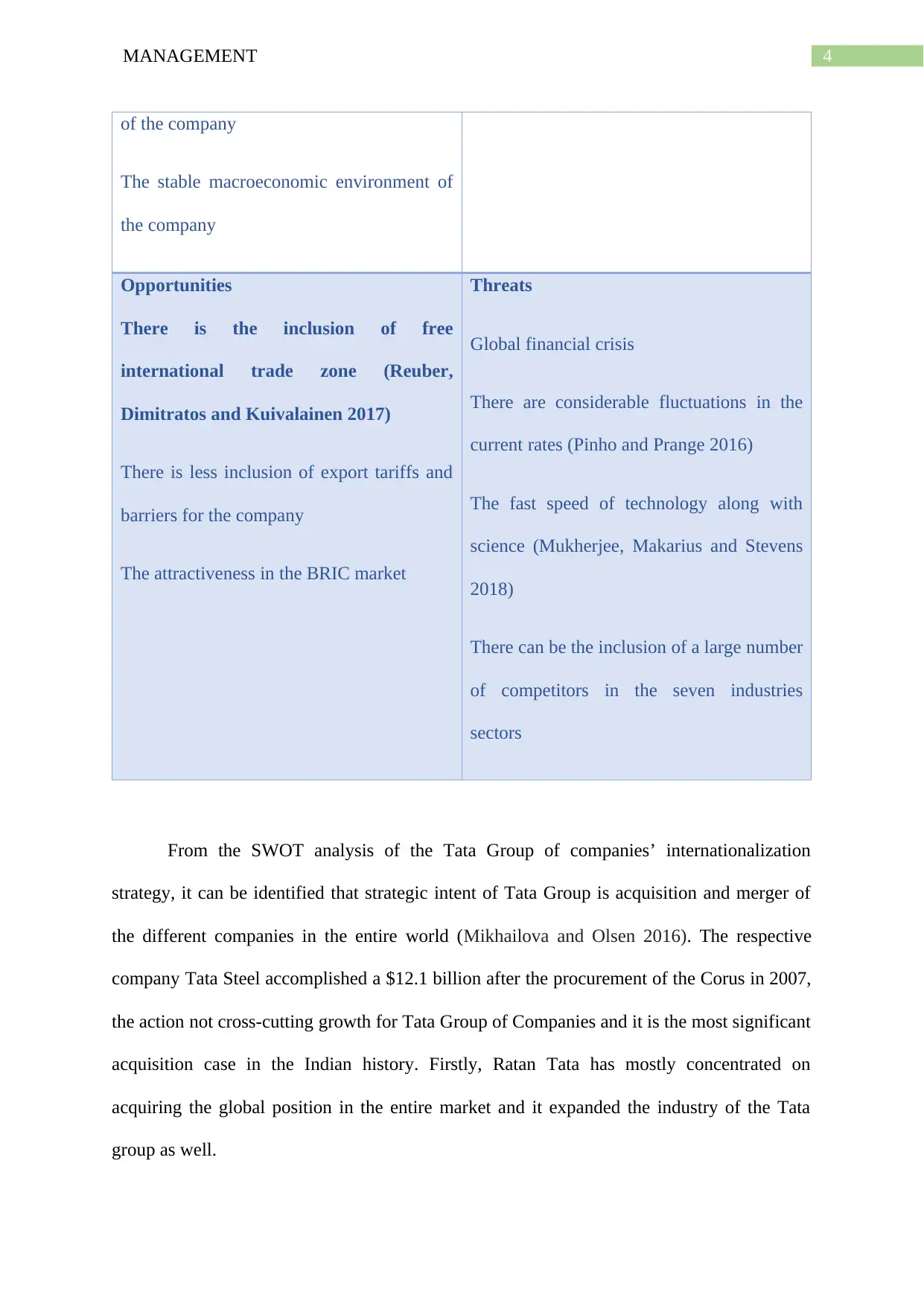
4MANAGEMENT
of the company
The stable macroeconomic environment of
the company
Opportunities
There is the inclusion of free
international trade zone (Reuber,
Dimitratos and Kuivalainen 2017)
There is less inclusion of export tariffs and
barriers for the company
The attractiveness in the BRIC market
Threats
Global financial crisis
There are considerable fluctuations in the
current rates (Pinho and Prange 2016)
The fast speed of technology along with
science (Mukherjee, Makarius and Stevens
2018)
There can be the inclusion of a large number
of competitors in the seven industries
sectors
From the SWOT analysis of the Tata Group of companies’ internationalization
strategy, it can be identified that strategic intent of Tata Group is acquisition and merger of
the different companies in the entire world (Mikhailova and Olsen 2016). The respective
company Tata Steel accomplished a $12.1 billion after the procurement of the Corus in 2007,
the action not cross-cutting growth for Tata Group of Companies and it is the most significant
acquisition case in the Indian history. Firstly, Ratan Tata has mostly concentrated on
acquiring the global position in the entire market and it expanded the industry of the Tata
group as well.
of the company
The stable macroeconomic environment of
the company
Opportunities
There is the inclusion of free
international trade zone (Reuber,
Dimitratos and Kuivalainen 2017)
There is less inclusion of export tariffs and
barriers for the company
The attractiveness in the BRIC market
Threats
Global financial crisis
There are considerable fluctuations in the
current rates (Pinho and Prange 2016)
The fast speed of technology along with
science (Mukherjee, Makarius and Stevens
2018)
There can be the inclusion of a large number
of competitors in the seven industries
sectors
From the SWOT analysis of the Tata Group of companies’ internationalization
strategy, it can be identified that strategic intent of Tata Group is acquisition and merger of
the different companies in the entire world (Mikhailova and Olsen 2016). The respective
company Tata Steel accomplished a $12.1 billion after the procurement of the Corus in 2007,
the action not cross-cutting growth for Tata Group of Companies and it is the most significant
acquisition case in the Indian history. Firstly, Ratan Tata has mostly concentrated on
acquiring the global position in the entire market and it expanded the industry of the Tata
group as well.
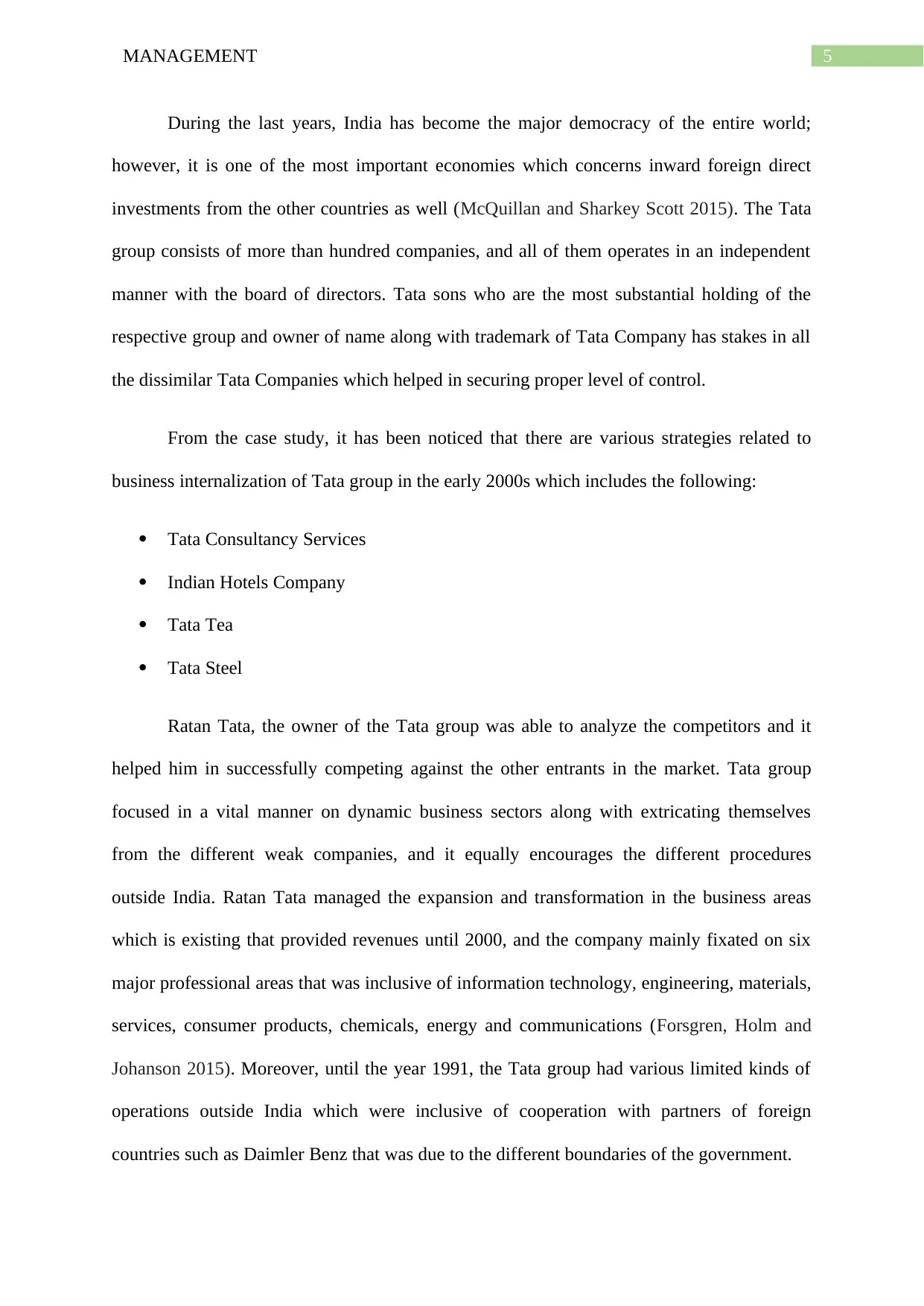
5MANAGEMENT
During the last years, India has become the major democracy of the entire world;
however, it is one of the most important economies which concerns inward foreign direct
investments from the other countries as well (McQuillan and Sharkey Scott 2015). The Tata
group consists of more than hundred companies, and all of them operates in an independent
manner with the board of directors. Tata sons who are the most substantial holding of the
respective group and owner of name along with trademark of Tata Company has stakes in all
the dissimilar Tata Companies which helped in securing proper level of control.
From the case study, it has been noticed that there are various strategies related to
business internalization of Tata group in the early 2000s which includes the following:
Tata Consultancy Services
Indian Hotels Company
Tata Tea
Tata Steel
Ratan Tata, the owner of the Tata group was able to analyze the competitors and it
helped him in successfully competing against the other entrants in the market. Tata group
focused in a vital manner on dynamic business sectors along with extricating themselves
from the different weak companies, and it equally encourages the different procedures
outside India. Ratan Tata managed the expansion and transformation in the business areas
which is existing that provided revenues until 2000, and the company mainly fixated on six
major professional areas that was inclusive of information technology, engineering, materials,
services, consumer products, chemicals, energy and communications (Forsgren, Holm and
Johanson 2015). Moreover, until the year 1991, the Tata group had various limited kinds of
operations outside India which were inclusive of cooperation with partners of foreign
countries such as Daimler Benz that was due to the different boundaries of the government.
During the last years, India has become the major democracy of the entire world;
however, it is one of the most important economies which concerns inward foreign direct
investments from the other countries as well (McQuillan and Sharkey Scott 2015). The Tata
group consists of more than hundred companies, and all of them operates in an independent
manner with the board of directors. Tata sons who are the most substantial holding of the
respective group and owner of name along with trademark of Tata Company has stakes in all
the dissimilar Tata Companies which helped in securing proper level of control.
From the case study, it has been noticed that there are various strategies related to
business internalization of Tata group in the early 2000s which includes the following:
Tata Consultancy Services
Indian Hotels Company
Tata Tea
Tata Steel
Ratan Tata, the owner of the Tata group was able to analyze the competitors and it
helped him in successfully competing against the other entrants in the market. Tata group
focused in a vital manner on dynamic business sectors along with extricating themselves
from the different weak companies, and it equally encourages the different procedures
outside India. Ratan Tata managed the expansion and transformation in the business areas
which is existing that provided revenues until 2000, and the company mainly fixated on six
major professional areas that was inclusive of information technology, engineering, materials,
services, consumer products, chemicals, energy and communications (Forsgren, Holm and
Johanson 2015). Moreover, until the year 1991, the Tata group had various limited kinds of
operations outside India which were inclusive of cooperation with partners of foreign
countries such as Daimler Benz that was due to the different boundaries of the government.
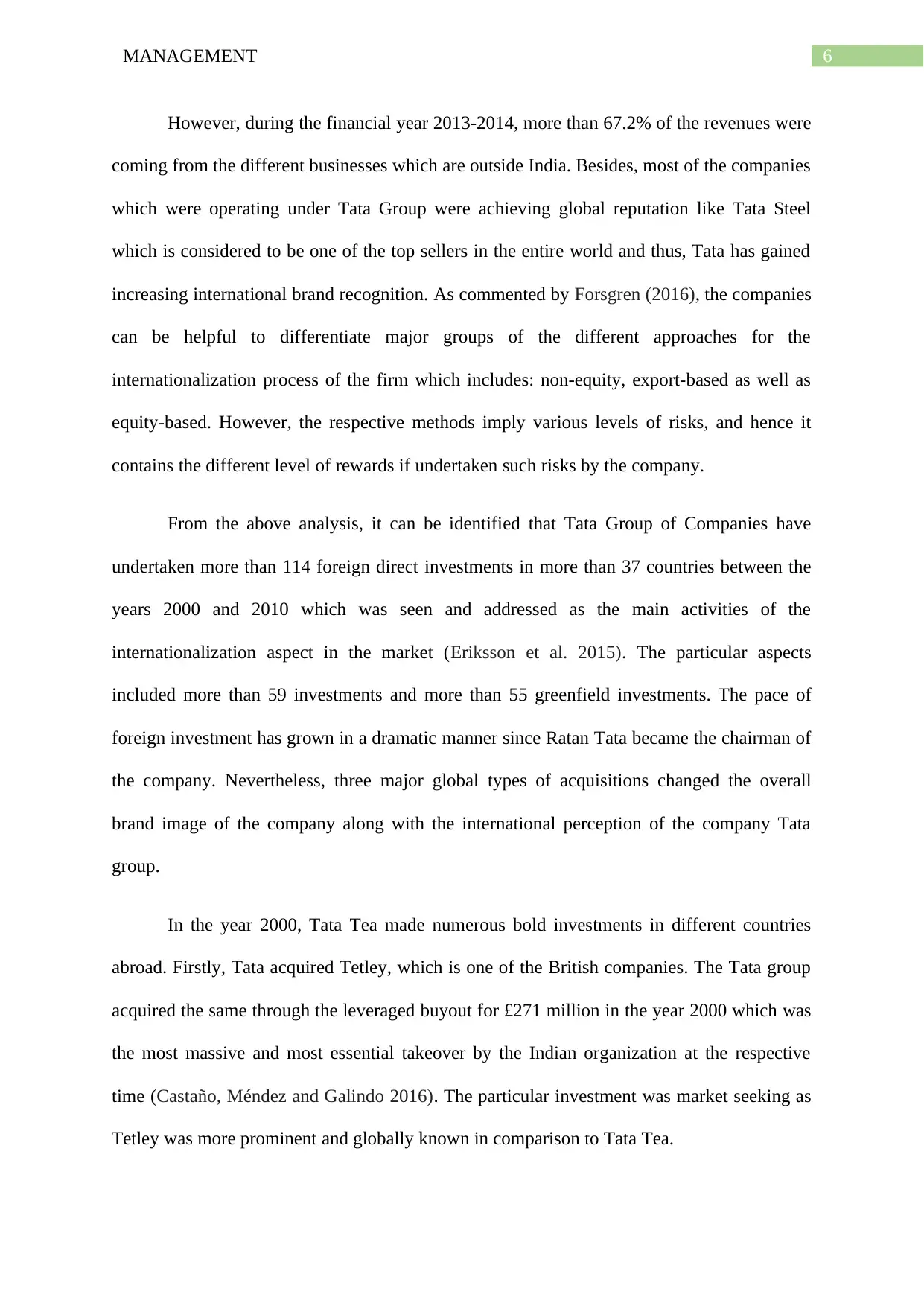
6MANAGEMENT
However, during the financial year 2013-2014, more than 67.2% of the revenues were
coming from the different businesses which are outside India. Besides, most of the companies
which were operating under Tata Group were achieving global reputation like Tata Steel
which is considered to be one of the top sellers in the entire world and thus, Tata has gained
increasing international brand recognition. As commented by Forsgren (2016), the companies
can be helpful to differentiate major groups of the different approaches for the
internationalization process of the firm which includes: non-equity, export-based as well as
equity-based. However, the respective methods imply various levels of risks, and hence it
contains the different level of rewards if undertaken such risks by the company.
From the above analysis, it can be identified that Tata Group of Companies have
undertaken more than 114 foreign direct investments in more than 37 countries between the
years 2000 and 2010 which was seen and addressed as the main activities of the
internationalization aspect in the market (Eriksson et al. 2015). The particular aspects
included more than 59 investments and more than 55 greenfield investments. The pace of
foreign investment has grown in a dramatic manner since Ratan Tata became the chairman of
the company. Nevertheless, three major global types of acquisitions changed the overall
brand image of the company along with the international perception of the company Tata
group.
In the year 2000, Tata Tea made numerous bold investments in different countries
abroad. Firstly, Tata acquired Tetley, which is one of the British companies. The Tata group
acquired the same through the leveraged buyout for £271 million in the year 2000 which was
the most massive and most essential takeover by the Indian organization at the respective
time (Castaño, Méndez and Galindo 2016). The particular investment was market seeking as
Tetley was more prominent and globally known in comparison to Tata Tea.
However, during the financial year 2013-2014, more than 67.2% of the revenues were
coming from the different businesses which are outside India. Besides, most of the companies
which were operating under Tata Group were achieving global reputation like Tata Steel
which is considered to be one of the top sellers in the entire world and thus, Tata has gained
increasing international brand recognition. As commented by Forsgren (2016), the companies
can be helpful to differentiate major groups of the different approaches for the
internationalization process of the firm which includes: non-equity, export-based as well as
equity-based. However, the respective methods imply various levels of risks, and hence it
contains the different level of rewards if undertaken such risks by the company.
From the above analysis, it can be identified that Tata Group of Companies have
undertaken more than 114 foreign direct investments in more than 37 countries between the
years 2000 and 2010 which was seen and addressed as the main activities of the
internationalization aspect in the market (Eriksson et al. 2015). The particular aspects
included more than 59 investments and more than 55 greenfield investments. The pace of
foreign investment has grown in a dramatic manner since Ratan Tata became the chairman of
the company. Nevertheless, three major global types of acquisitions changed the overall
brand image of the company along with the international perception of the company Tata
group.
In the year 2000, Tata Tea made numerous bold investments in different countries
abroad. Firstly, Tata acquired Tetley, which is one of the British companies. The Tata group
acquired the same through the leveraged buyout for £271 million in the year 2000 which was
the most massive and most essential takeover by the Indian organization at the respective
time (Castaño, Méndez and Galindo 2016). The particular investment was market seeking as
Tetley was more prominent and globally known in comparison to Tata Tea.
Paraphrase This Document
Need a fresh take? Get an instant paraphrase of this document with our AI Paraphraser
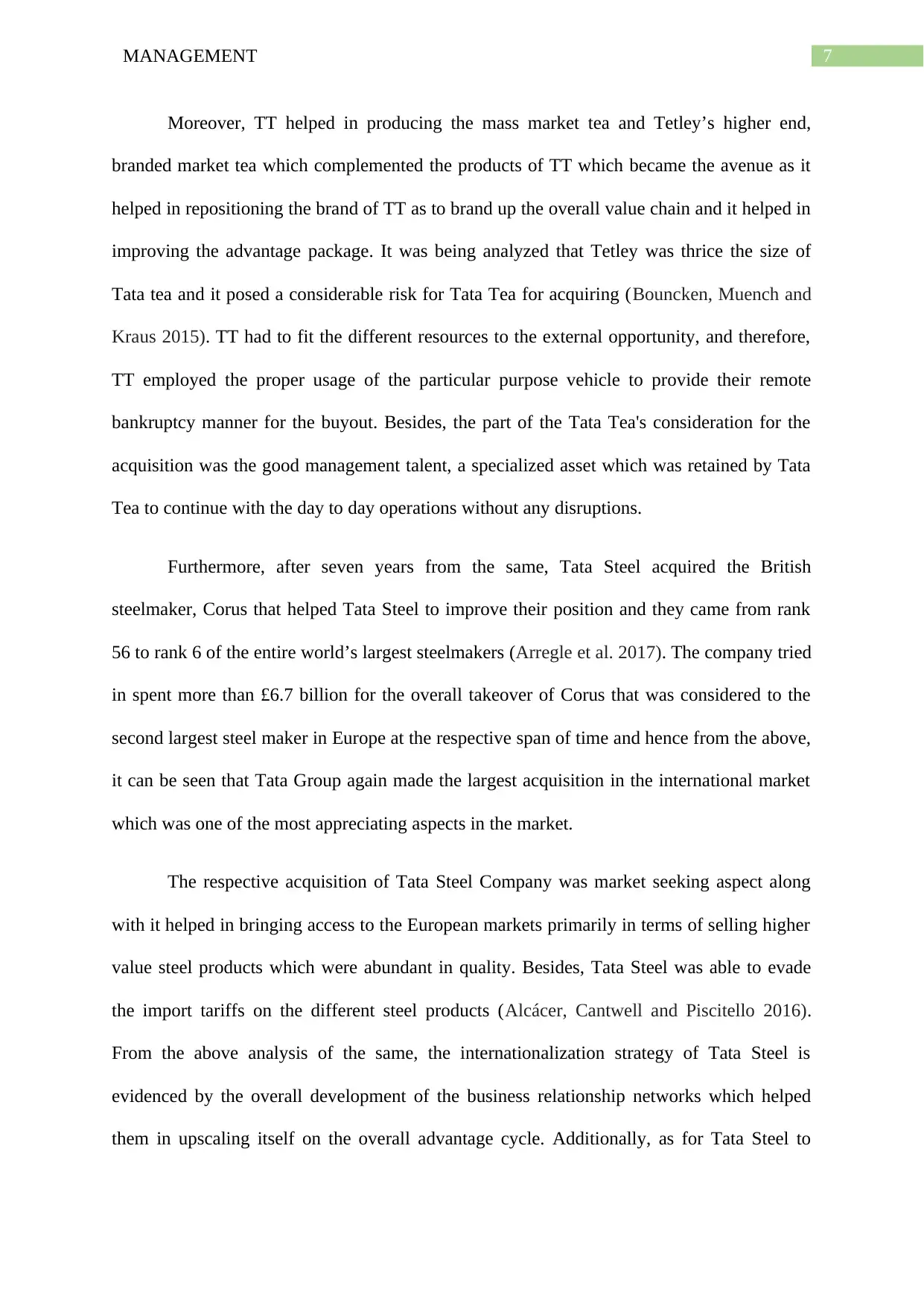
7MANAGEMENT
Moreover, TT helped in producing the mass market tea and Tetley’s higher end,
branded market tea which complemented the products of TT which became the avenue as it
helped in repositioning the brand of TT as to brand up the overall value chain and it helped in
improving the advantage package. It was being analyzed that Tetley was thrice the size of
Tata tea and it posed a considerable risk for Tata Tea for acquiring (Bouncken, Muench and
Kraus 2015). TT had to fit the different resources to the external opportunity, and therefore,
TT employed the proper usage of the particular purpose vehicle to provide their remote
bankruptcy manner for the buyout. Besides, the part of the Tata Tea's consideration for the
acquisition was the good management talent, a specialized asset which was retained by Tata
Tea to continue with the day to day operations without any disruptions.
Furthermore, after seven years from the same, Tata Steel acquired the British
steelmaker, Corus that helped Tata Steel to improve their position and they came from rank
56 to rank 6 of the entire world’s largest steelmakers (Arregle et al. 2017). The company tried
in spent more than £6.7 billion for the overall takeover of Corus that was considered to the
second largest steel maker in Europe at the respective span of time and hence from the above,
it can be seen that Tata Group again made the largest acquisition in the international market
which was one of the most appreciating aspects in the market.
The respective acquisition of Tata Steel Company was market seeking aspect along
with it helped in bringing access to the European markets primarily in terms of selling higher
value steel products which were abundant in quality. Besides, Tata Steel was able to evade
the import tariffs on the different steel products (Alcácer, Cantwell and Piscitello 2016).
From the above analysis of the same, the internationalization strategy of Tata Steel is
evidenced by the overall development of the business relationship networks which helped
them in upscaling itself on the overall advantage cycle. Additionally, as for Tata Steel to
Moreover, TT helped in producing the mass market tea and Tetley’s higher end,
branded market tea which complemented the products of TT which became the avenue as it
helped in repositioning the brand of TT as to brand up the overall value chain and it helped in
improving the advantage package. It was being analyzed that Tetley was thrice the size of
Tata tea and it posed a considerable risk for Tata Tea for acquiring (Bouncken, Muench and
Kraus 2015). TT had to fit the different resources to the external opportunity, and therefore,
TT employed the proper usage of the particular purpose vehicle to provide their remote
bankruptcy manner for the buyout. Besides, the part of the Tata Tea's consideration for the
acquisition was the good management talent, a specialized asset which was retained by Tata
Tea to continue with the day to day operations without any disruptions.
Furthermore, after seven years from the same, Tata Steel acquired the British
steelmaker, Corus that helped Tata Steel to improve their position and they came from rank
56 to rank 6 of the entire world’s largest steelmakers (Arregle et al. 2017). The company tried
in spent more than £6.7 billion for the overall takeover of Corus that was considered to the
second largest steel maker in Europe at the respective span of time and hence from the above,
it can be seen that Tata Group again made the largest acquisition in the international market
which was one of the most appreciating aspects in the market.
The respective acquisition of Tata Steel Company was market seeking aspect along
with it helped in bringing access to the European markets primarily in terms of selling higher
value steel products which were abundant in quality. Besides, Tata Steel was able to evade
the import tariffs on the different steel products (Alcácer, Cantwell and Piscitello 2016).
From the above analysis of the same, the internationalization strategy of Tata Steel is
evidenced by the overall development of the business relationship networks which helped
them in upscaling itself on the overall advantage cycle. Additionally, as for Tata Steel to
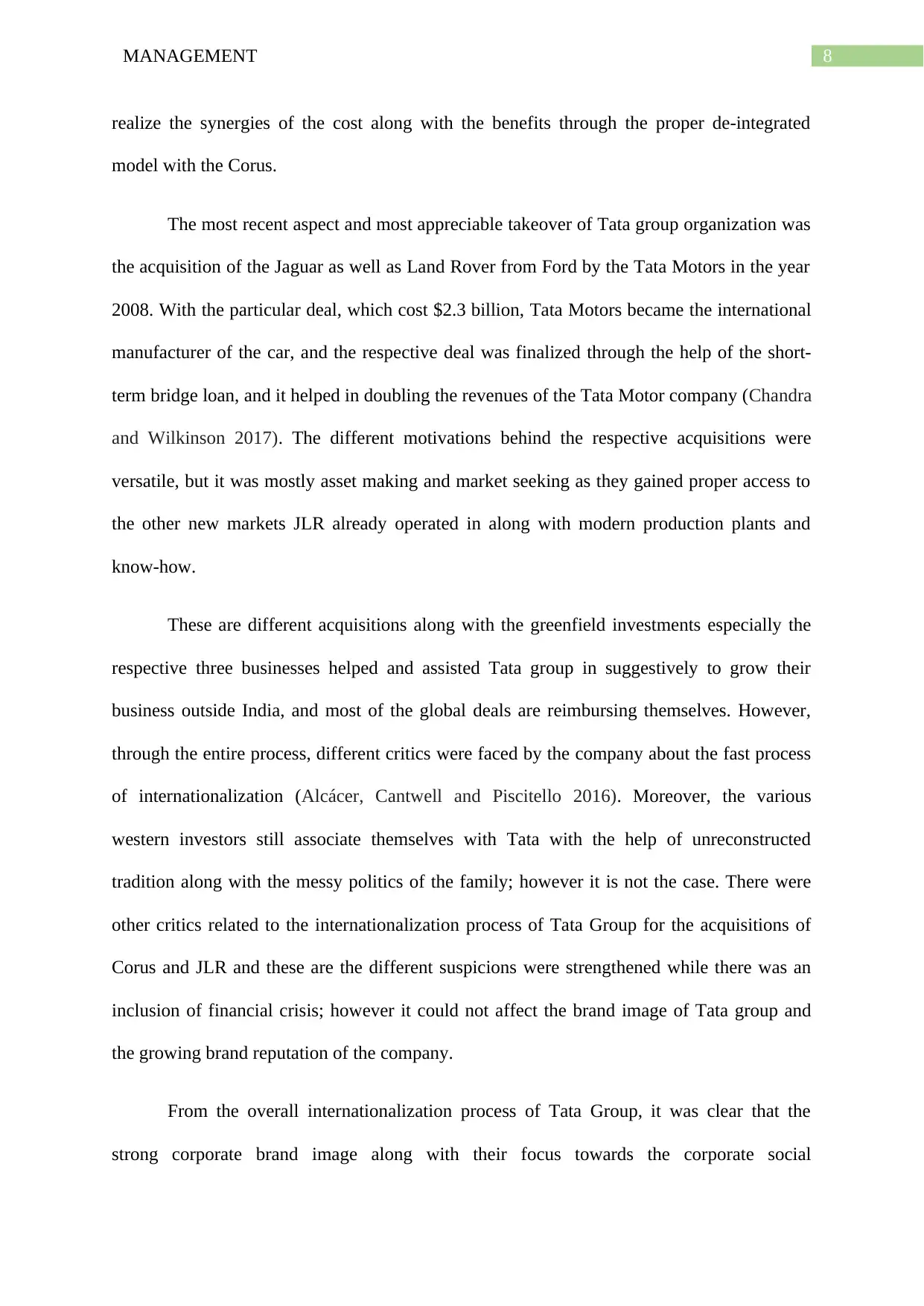
8MANAGEMENT
realize the synergies of the cost along with the benefits through the proper de-integrated
model with the Corus.
The most recent aspect and most appreciable takeover of Tata group organization was
the acquisition of the Jaguar as well as Land Rover from Ford by the Tata Motors in the year
2008. With the particular deal, which cost $2.3 billion, Tata Motors became the international
manufacturer of the car, and the respective deal was finalized through the help of the short-
term bridge loan, and it helped in doubling the revenues of the Tata Motor company (Chandra
and Wilkinson 2017). The different motivations behind the respective acquisitions were
versatile, but it was mostly asset making and market seeking as they gained proper access to
the other new markets JLR already operated in along with modern production plants and
know-how.
These are different acquisitions along with the greenfield investments especially the
respective three businesses helped and assisted Tata group in suggestively to grow their
business outside India, and most of the global deals are reimbursing themselves. However,
through the entire process, different critics were faced by the company about the fast process
of internationalization (Alcácer, Cantwell and Piscitello 2016). Moreover, the various
western investors still associate themselves with Tata with the help of unreconstructed
tradition along with the messy politics of the family; however it is not the case. There were
other critics related to the internationalization process of Tata Group for the acquisitions of
Corus and JLR and these are the different suspicions were strengthened while there was an
inclusion of financial crisis; however it could not affect the brand image of Tata group and
the growing brand reputation of the company.
From the overall internationalization process of Tata Group, it was clear that the
strong corporate brand image along with their focus towards the corporate social
realize the synergies of the cost along with the benefits through the proper de-integrated
model with the Corus.
The most recent aspect and most appreciable takeover of Tata group organization was
the acquisition of the Jaguar as well as Land Rover from Ford by the Tata Motors in the year
2008. With the particular deal, which cost $2.3 billion, Tata Motors became the international
manufacturer of the car, and the respective deal was finalized through the help of the short-
term bridge loan, and it helped in doubling the revenues of the Tata Motor company (Chandra
and Wilkinson 2017). The different motivations behind the respective acquisitions were
versatile, but it was mostly asset making and market seeking as they gained proper access to
the other new markets JLR already operated in along with modern production plants and
know-how.
These are different acquisitions along with the greenfield investments especially the
respective three businesses helped and assisted Tata group in suggestively to grow their
business outside India, and most of the global deals are reimbursing themselves. However,
through the entire process, different critics were faced by the company about the fast process
of internationalization (Alcácer, Cantwell and Piscitello 2016). Moreover, the various
western investors still associate themselves with Tata with the help of unreconstructed
tradition along with the messy politics of the family; however it is not the case. There were
other critics related to the internationalization process of Tata Group for the acquisitions of
Corus and JLR and these are the different suspicions were strengthened while there was an
inclusion of financial crisis; however it could not affect the brand image of Tata group and
the growing brand reputation of the company.
From the overall internationalization process of Tata Group, it was clear that the
strong corporate brand image along with their focus towards the corporate social
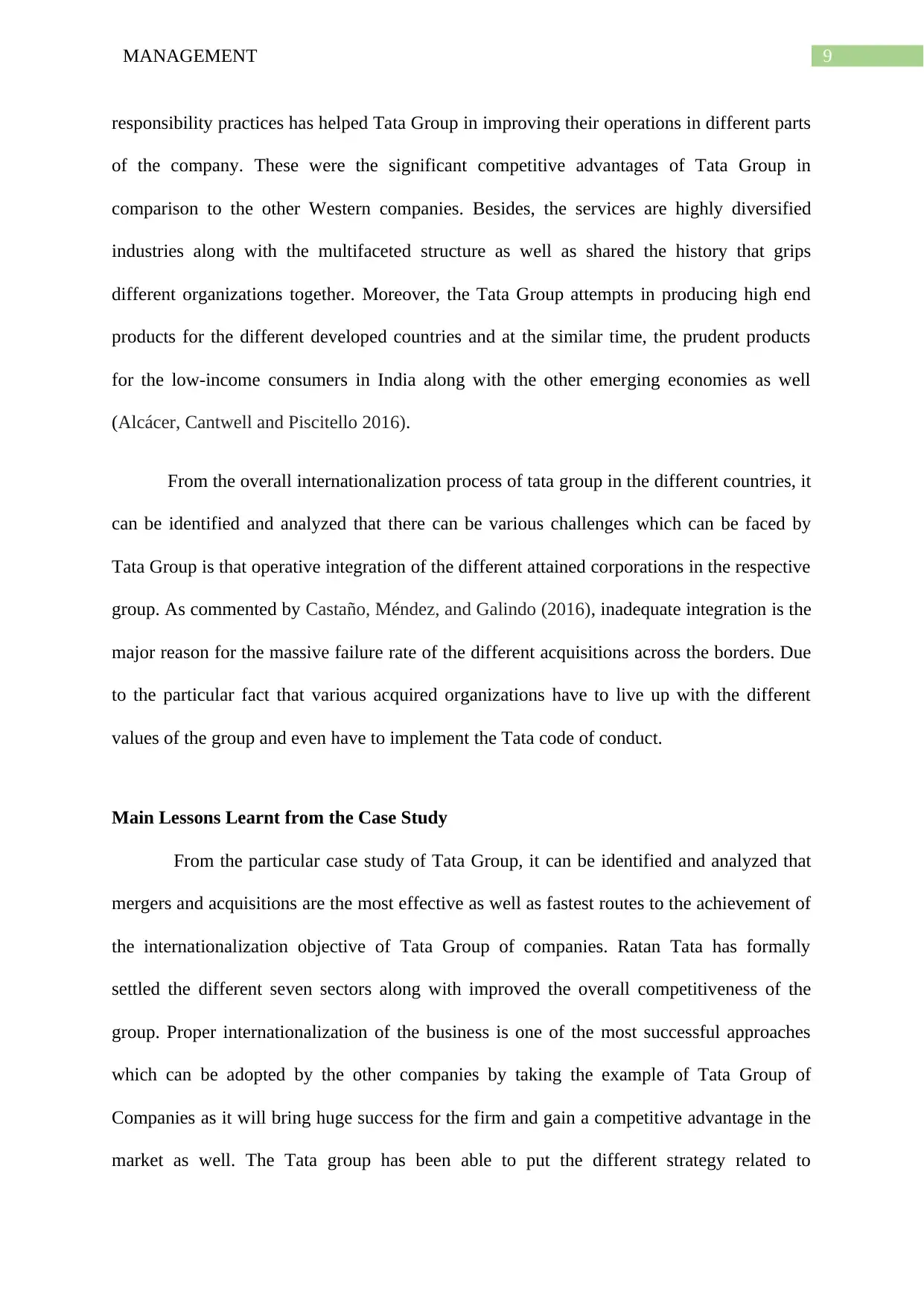
9MANAGEMENT
responsibility practices has helped Tata Group in improving their operations in different parts
of the company. These were the significant competitive advantages of Tata Group in
comparison to the other Western companies. Besides, the services are highly diversified
industries along with the multifaceted structure as well as shared the history that grips
different organizations together. Moreover, the Tata Group attempts in producing high end
products for the different developed countries and at the similar time, the prudent products
for the low-income consumers in India along with the other emerging economies as well
(Alcácer, Cantwell and Piscitello 2016).
From the overall internationalization process of tata group in the different countries, it
can be identified and analyzed that there can be various challenges which can be faced by
Tata Group is that operative integration of the different attained corporations in the respective
group. As commented by Castaño, Méndez, and Galindo (2016), inadequate integration is the
major reason for the massive failure rate of the different acquisitions across the borders. Due
to the particular fact that various acquired organizations have to live up with the different
values of the group and even have to implement the Tata code of conduct.
Main Lessons Learnt from the Case Study
From the particular case study of Tata Group, it can be identified and analyzed that
mergers and acquisitions are the most effective as well as fastest routes to the achievement of
the internationalization objective of Tata Group of companies. Ratan Tata has formally
settled the different seven sectors along with improved the overall competitiveness of the
group. Proper internationalization of the business is one of the most successful approaches
which can be adopted by the other companies by taking the example of Tata Group of
Companies as it will bring huge success for the firm and gain a competitive advantage in the
market as well. The Tata group has been able to put the different strategy related to
responsibility practices has helped Tata Group in improving their operations in different parts
of the company. These were the significant competitive advantages of Tata Group in
comparison to the other Western companies. Besides, the services are highly diversified
industries along with the multifaceted structure as well as shared the history that grips
different organizations together. Moreover, the Tata Group attempts in producing high end
products for the different developed countries and at the similar time, the prudent products
for the low-income consumers in India along with the other emerging economies as well
(Alcácer, Cantwell and Piscitello 2016).
From the overall internationalization process of tata group in the different countries, it
can be identified and analyzed that there can be various challenges which can be faced by
Tata Group is that operative integration of the different attained corporations in the respective
group. As commented by Castaño, Méndez, and Galindo (2016), inadequate integration is the
major reason for the massive failure rate of the different acquisitions across the borders. Due
to the particular fact that various acquired organizations have to live up with the different
values of the group and even have to implement the Tata code of conduct.
Main Lessons Learnt from the Case Study
From the particular case study of Tata Group, it can be identified and analyzed that
mergers and acquisitions are the most effective as well as fastest routes to the achievement of
the internationalization objective of Tata Group of companies. Ratan Tata has formally
settled the different seven sectors along with improved the overall competitiveness of the
group. Proper internationalization of the business is one of the most successful approaches
which can be adopted by the other companies by taking the example of Tata Group of
Companies as it will bring huge success for the firm and gain a competitive advantage in the
market as well. The Tata group has been able to put the different strategy related to
Secure Best Marks with AI Grader
Need help grading? Try our AI Grader for instant feedback on your assignments.
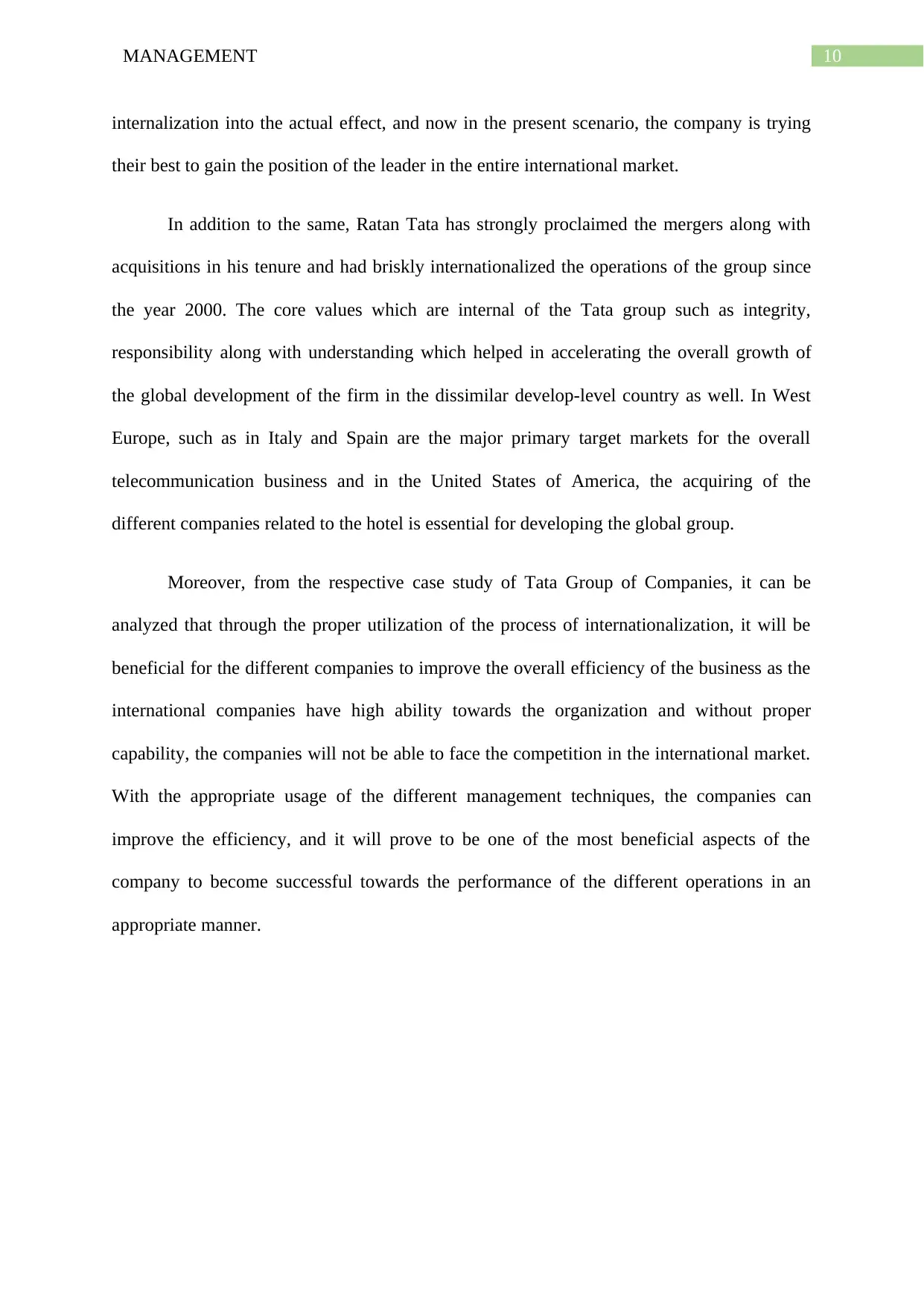
10MANAGEMENT
internalization into the actual effect, and now in the present scenario, the company is trying
their best to gain the position of the leader in the entire international market.
In addition to the same, Ratan Tata has strongly proclaimed the mergers along with
acquisitions in his tenure and had briskly internationalized the operations of the group since
the year 2000. The core values which are internal of the Tata group such as integrity,
responsibility along with understanding which helped in accelerating the overall growth of
the global development of the firm in the dissimilar develop-level country as well. In West
Europe, such as in Italy and Spain are the major primary target markets for the overall
telecommunication business and in the United States of America, the acquiring of the
different companies related to the hotel is essential for developing the global group.
Moreover, from the respective case study of Tata Group of Companies, it can be
analyzed that through the proper utilization of the process of internationalization, it will be
beneficial for the different companies to improve the overall efficiency of the business as the
international companies have high ability towards the organization and without proper
capability, the companies will not be able to face the competition in the international market.
With the appropriate usage of the different management techniques, the companies can
improve the efficiency, and it will prove to be one of the most beneficial aspects of the
company to become successful towards the performance of the different operations in an
appropriate manner.
internalization into the actual effect, and now in the present scenario, the company is trying
their best to gain the position of the leader in the entire international market.
In addition to the same, Ratan Tata has strongly proclaimed the mergers along with
acquisitions in his tenure and had briskly internationalized the operations of the group since
the year 2000. The core values which are internal of the Tata group such as integrity,
responsibility along with understanding which helped in accelerating the overall growth of
the global development of the firm in the dissimilar develop-level country as well. In West
Europe, such as in Italy and Spain are the major primary target markets for the overall
telecommunication business and in the United States of America, the acquiring of the
different companies related to the hotel is essential for developing the global group.
Moreover, from the respective case study of Tata Group of Companies, it can be
analyzed that through the proper utilization of the process of internationalization, it will be
beneficial for the different companies to improve the overall efficiency of the business as the
international companies have high ability towards the organization and without proper
capability, the companies will not be able to face the competition in the international market.
With the appropriate usage of the different management techniques, the companies can
improve the efficiency, and it will prove to be one of the most beneficial aspects of the
company to become successful towards the performance of the different operations in an
appropriate manner.
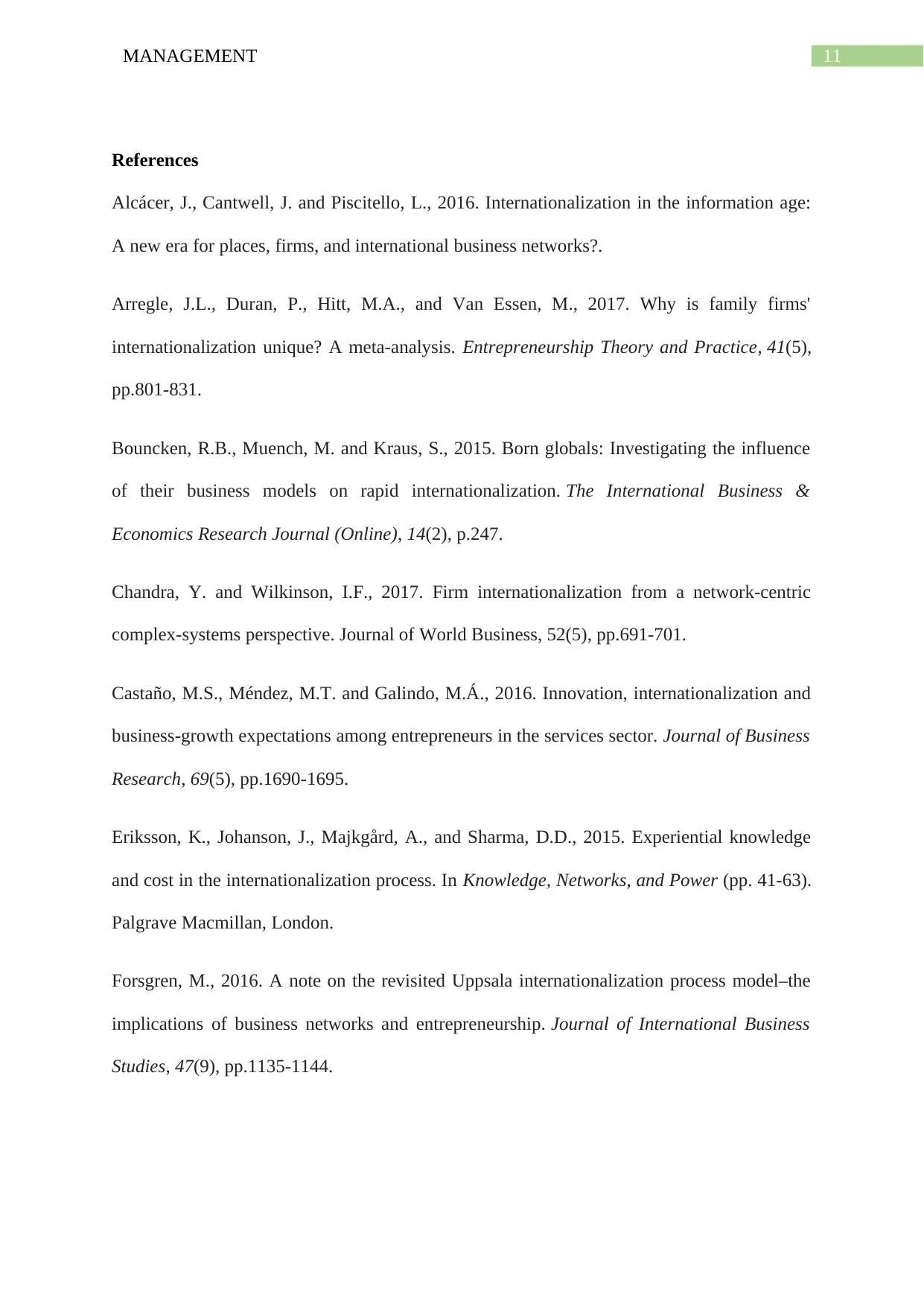
11MANAGEMENT
References
Alcácer, J., Cantwell, J. and Piscitello, L., 2016. Internationalization in the information age:
A new era for places, firms, and international business networks?.
Arregle, J.L., Duran, P., Hitt, M.A., and Van Essen, M., 2017. Why is family firms'
internationalization unique? A meta-analysis. Entrepreneurship Theory and Practice, 41(5),
pp.801-831.
Bouncken, R.B., Muench, M. and Kraus, S., 2015. Born globals: Investigating the influence
of their business models on rapid internationalization. The International Business &
Economics Research Journal (Online), 14(2), p.247.
Chandra, Y. and Wilkinson, I.F., 2017. Firm internationalization from a network-centric
complex-systems perspective. Journal of World Business, 52(5), pp.691-701.
Castaño, M.S., Méndez, M.T. and Galindo, M.Á., 2016. Innovation, internationalization and
business-growth expectations among entrepreneurs in the services sector. Journal of Business
Research, 69(5), pp.1690-1695.
Eriksson, K., Johanson, J., Majkgård, A., and Sharma, D.D., 2015. Experiential knowledge
and cost in the internationalization process. In Knowledge, Networks, and Power (pp. 41-63).
Palgrave Macmillan, London.
Forsgren, M., 2016. A note on the revisited Uppsala internationalization process model–the
implications of business networks and entrepreneurship. Journal of International Business
Studies, 47(9), pp.1135-1144.
References
Alcácer, J., Cantwell, J. and Piscitello, L., 2016. Internationalization in the information age:
A new era for places, firms, and international business networks?.
Arregle, J.L., Duran, P., Hitt, M.A., and Van Essen, M., 2017. Why is family firms'
internationalization unique? A meta-analysis. Entrepreneurship Theory and Practice, 41(5),
pp.801-831.
Bouncken, R.B., Muench, M. and Kraus, S., 2015. Born globals: Investigating the influence
of their business models on rapid internationalization. The International Business &
Economics Research Journal (Online), 14(2), p.247.
Chandra, Y. and Wilkinson, I.F., 2017. Firm internationalization from a network-centric
complex-systems perspective. Journal of World Business, 52(5), pp.691-701.
Castaño, M.S., Méndez, M.T. and Galindo, M.Á., 2016. Innovation, internationalization and
business-growth expectations among entrepreneurs in the services sector. Journal of Business
Research, 69(5), pp.1690-1695.
Eriksson, K., Johanson, J., Majkgård, A., and Sharma, D.D., 2015. Experiential knowledge
and cost in the internationalization process. In Knowledge, Networks, and Power (pp. 41-63).
Palgrave Macmillan, London.
Forsgren, M., 2016. A note on the revisited Uppsala internationalization process model–the
implications of business networks and entrepreneurship. Journal of International Business
Studies, 47(9), pp.1135-1144.
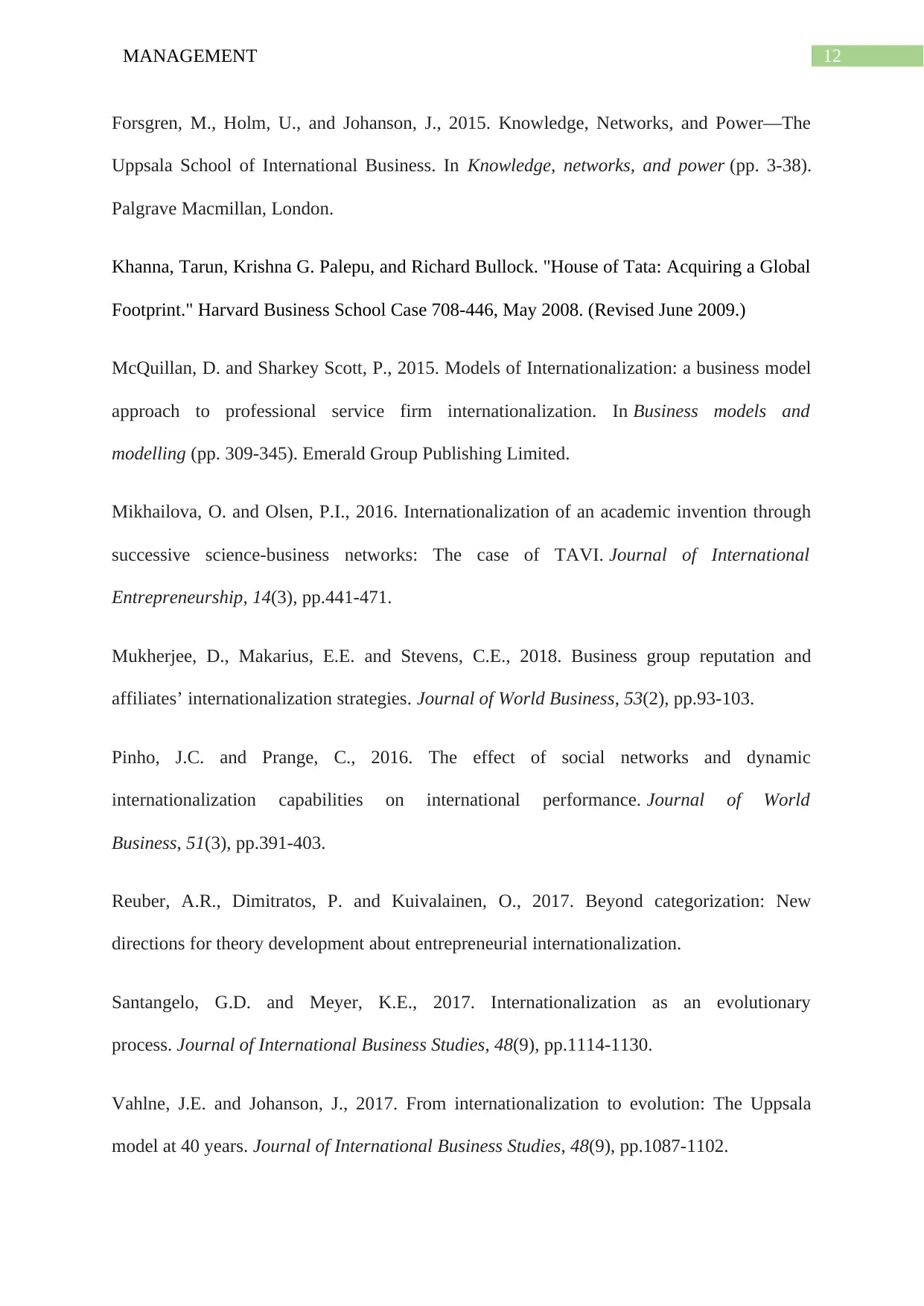
12MANAGEMENT
Forsgren, M., Holm, U., and Johanson, J., 2015. Knowledge, Networks, and Power—The
Uppsala School of International Business. In Knowledge, networks, and power (pp. 3-38).
Palgrave Macmillan, London.
Khanna, Tarun, Krishna G. Palepu, and Richard Bullock. "House of Tata: Acquiring a Global
Footprint." Harvard Business School Case 708-446, May 2008. (Revised June 2009.)
McQuillan, D. and Sharkey Scott, P., 2015. Models of Internationalization: a business model
approach to professional service firm internationalization. In Business models and
modelling (pp. 309-345). Emerald Group Publishing Limited.
Mikhailova, O. and Olsen, P.I., 2016. Internationalization of an academic invention through
successive science-business networks: The case of TAVI. Journal of International
Entrepreneurship, 14(3), pp.441-471.
Mukherjee, D., Makarius, E.E. and Stevens, C.E., 2018. Business group reputation and
affiliates’ internationalization strategies. Journal of World Business, 53(2), pp.93-103.
Pinho, J.C. and Prange, C., 2016. The effect of social networks and dynamic
internationalization capabilities on international performance. Journal of World
Business, 51(3), pp.391-403.
Reuber, A.R., Dimitratos, P. and Kuivalainen, O., 2017. Beyond categorization: New
directions for theory development about entrepreneurial internationalization.
Santangelo, G.D. and Meyer, K.E., 2017. Internationalization as an evolutionary
process. Journal of International Business Studies, 48(9), pp.1114-1130.
Vahlne, J.E. and Johanson, J., 2017. From internationalization to evolution: The Uppsala
model at 40 years. Journal of International Business Studies, 48(9), pp.1087-1102.
Forsgren, M., Holm, U., and Johanson, J., 2015. Knowledge, Networks, and Power—The
Uppsala School of International Business. In Knowledge, networks, and power (pp. 3-38).
Palgrave Macmillan, London.
Khanna, Tarun, Krishna G. Palepu, and Richard Bullock. "House of Tata: Acquiring a Global
Footprint." Harvard Business School Case 708-446, May 2008. (Revised June 2009.)
McQuillan, D. and Sharkey Scott, P., 2015. Models of Internationalization: a business model
approach to professional service firm internationalization. In Business models and
modelling (pp. 309-345). Emerald Group Publishing Limited.
Mikhailova, O. and Olsen, P.I., 2016. Internationalization of an academic invention through
successive science-business networks: The case of TAVI. Journal of International
Entrepreneurship, 14(3), pp.441-471.
Mukherjee, D., Makarius, E.E. and Stevens, C.E., 2018. Business group reputation and
affiliates’ internationalization strategies. Journal of World Business, 53(2), pp.93-103.
Pinho, J.C. and Prange, C., 2016. The effect of social networks and dynamic
internationalization capabilities on international performance. Journal of World
Business, 51(3), pp.391-403.
Reuber, A.R., Dimitratos, P. and Kuivalainen, O., 2017. Beyond categorization: New
directions for theory development about entrepreneurial internationalization.
Santangelo, G.D. and Meyer, K.E., 2017. Internationalization as an evolutionary
process. Journal of International Business Studies, 48(9), pp.1114-1130.
Vahlne, J.E. and Johanson, J., 2017. From internationalization to evolution: The Uppsala
model at 40 years. Journal of International Business Studies, 48(9), pp.1087-1102.
Paraphrase This Document
Need a fresh take? Get an instant paraphrase of this document with our AI Paraphraser

13MANAGEMENT
1 out of 14
Related Documents
Your All-in-One AI-Powered Toolkit for Academic Success.
+13062052269
info@desklib.com
Available 24*7 on WhatsApp / Email
![[object Object]](/_next/static/media/star-bottom.7253800d.svg)
Unlock your academic potential
© 2024 | Zucol Services PVT LTD | All rights reserved.




